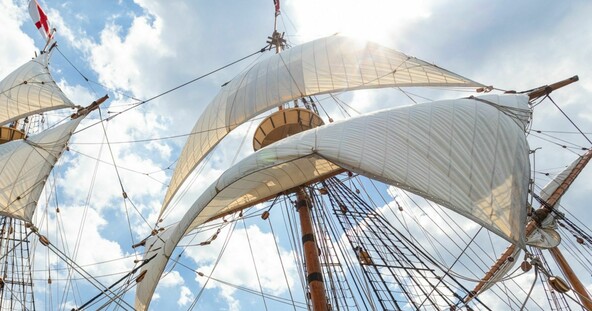
- Plan Your Visit
- Explore Our Sites

Mayflower II
Along with national treasures such as the statue of liberty and the lincoln memorial, mayflower is an iconic symbol of freedom..
Of the hundreds of ships that made the transatlantic crossing in the 1600s, she is the ship we remember. Three hundred years later, on June 13, 1957, a full-scale reproduction arrived in Plymouth Harbor, Mayflower II .
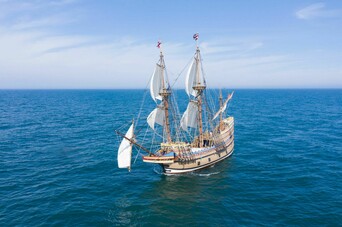
Since then, Mayflower II has become the majestic centerpiece of historic Plymouth Harbor, and the Commonwealth of Massachusetts. In many ways, America is the product of the events that happened in Plymouth and Native Patuxet over four centuries ago—the choices made, risks taken, and the adaptation of community structures to new civic realities.
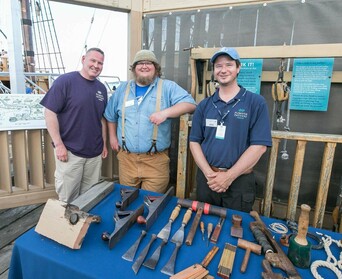
Mayflower II tangibly embodies those choices and risks for hundreds of thousands of lifelong learners each year. More than twenty-five million people have stepped aboard her decks to imagine the perils and contemplate the modern impacts of the historic crossing.
Today, Mayflower II is a floating classroom and working vessel. Following her restoration and return to Plymouth in 2020, she was added to the National Register of Historic Places, illuminating that she is a historic ship in her own right.
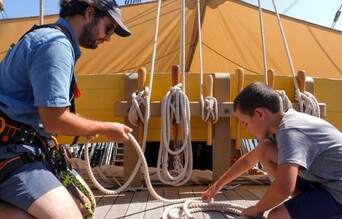
"Like most people, I was immediately struck by how small the ship seemed - particularly in the 'tween decks, where the passengers were confined. How could 102 people, including three pregnant mothers, have survived more than ten weeks in a space this size?" —Nathaniel Philbrick, "At Sea with the Pilgrims: Writing About the Voyage of the Mayflower, " Plimoth Life, 2007.
Frequently Asked Questions
Mayflower is a square-rigged vessel that is about 25 feet wide and 106 feet long, displacing 236 tons of water. She has four masts, including a mainmast, foremast, mizzen, and sprit, with a total of six sails. You may walk around the main deck, orlop deck, and half deck.
Mayflower is not fully accessible. People with difficulty walking should be aware that there are ramps that can be steep according to the rise and fall of the tides. On the ship, there are also several flights of stairs to climb. However, those unable to board the ship may enjoy a close-up view of Mayflower from the dock, visit the dockside exhibit area, talk to modern crewmembers, and look at photographs of the interior of the ship.
Yes, we encourage you to take photographs or use video cameras for your own use. You need not ask permission of the staff to take pictures of Mayflower . Commercial use of photographs or video is prohibited without permission from our Public Relations office.
No one knows for sure what happened to the original Mayflower . The last record of the ship was an assessment of her value in 1624. After that, she disappeared from maritime records. Several places in England claim to have a piece of the original ship, but there is no historical proof to support these claims.
Mayflower passengers lived on board anywhere from seven to nine months depending on when they joined the voyage and how soon they left the ship for shelter on land.
One of the most notable differences is the large modern staircase between the main deck and the lower decks. (In the 17th century, ladders were used). Electric lights illuminating the dark corners of the lower deck were also not standard in the 1600s! There were other minor modifications made to Mayflower to make sure that she would be more accessible, safe, and comfortable for the visiting public.
Mayflower II : Her Story
Under construction.
A reproduction ship was always part of Harry Hornblower’s vision for Plimoth Patuxet Museums (learn more about his vision here). In 1951 Plimoth Patuxet (then known as Plimoth Plantation) contracted naval architect, William A. Baker, to research and design plans for a ship the size and type of the original Mayflower. At nearly the same time, unbeknownst to Plimoth Patuxet, a similar project was developing in England. Warwick Charlton founded Project Mayflower Ltd. to honor the alliance of friendship forged between the United States and United Kingdom during World War II. Charlton’s team came across an article written by Baker, and after connecting with Plimoth Patuxet, a new partnership was born. Plimoth Patuxet provided Baker’s research and plans to Project Mayflower Ltd. Of course, that is just the start of Mayflower II’ s journey!
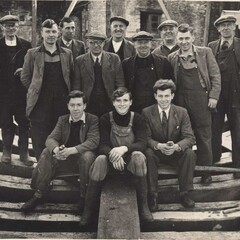
[ Above Photo Captions: Photo 1: Generations of shipwrights on Mayflower II’s frame at the J.W. & A. Upham Shipyard; Photo 2: A shipwright works in the hull of Mayflower II . Note the “Mayflower” banner flown between a United States and United Kingdom flag; Photo 3. Shipwrights, community members, dignitaries, and project leaders gather for the keel laying ceremony in July 1955. Note the United Kingdom and American flags tied together above the bean in tribute to the friendship between the two countries the ship exemplified following World War II; Photo 4: A shipwright works on Mayflower II using traditional 17th-century methods and tools. Photo 5: View of Mayflower II’s Main deck and Beak; Photo 6: Mayflower II , nearing completion and being rigged by shipwrights in Brixham. ]
Her Maiden Voyage
Mayflower II set sail from Plymouth, England on April 20, 1957 with a crew of thirty-three men under the command of acclaimed Captain Alan Villiers. As they neared Massachusetts shores, Mayflower II ran into a violent squall. No one aboard had experience with handling a 17th-century vessel in inclement weather. However, Captain Villiers remembered that William Bradford, famed Governor of Plymouth Colony and passenger aboard the original Mayflower during her 1620 voyage, wrote in his manuscript, Of Plimoth Plantation , how Master Christopher Jones steered the original ship to safety during the 1620 voyage by lying ahull. Quickly recalling this note, Villiers and the crew executed the same maneuvers and calmly rode out the storm. On June 13, 1957 Mayflower II arrived in Plymouth, Massachusetts to a crowd of 25,000 adoring spectators.
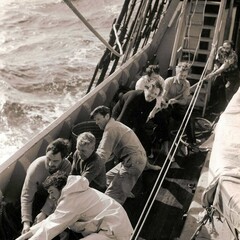
[Above Photo Captions: Photo 1: Stuart Upham, second from rear, hauls a line with fellow Mayflower II crew members in 1957; Photo 2: Mayflower II undersail in the Atlantic Ocean; Photo 3: A selection of images of the crew aboard Mayflower II during her 1957 maiden voyage. Top right, a batch of rolls fresh out of the oven in Mayflower II ’s galley. Top left, crew members demonstrate 17th-century medical procedures with leeches while under sail. Bottom right, Captain Villiers delivers a Sunday service to the crew. Bottom left, a crew member sketches and paints; Photo 4: A selection of images from the 1957 voyage. Top right, crew members dressed in Pilgrim attire on the Main deck. Top left, Captain Villiers, in Pilgrim attire, addresses his crew on the Main deck. Bottom right, a crew member at the ship’s wheel during the day. Bottom left, a crew member at the ship’s wheel at night; Photo 5: The 1957 Mayflower II crew with Captain Villiers; Photo 6: Mayflower II arrives in Plymouth on June 13, 1957 and is greeted by thousands of spectators along the waterfront. ]
Her Triumphant Restoration
“ Mayflower II is a source of inspiration to those in search of new beginnings and the possibility of multicultural cooperation in this nation of immigrants. Upon her return to Plymouth Harbor she once again became a kind of time machine…to a past that only gains in resonance and importance with each passing day.”—Nathaniel Philbrick
After 3+ years of restoration and 3 weeks of sea trials, on August 10, 2020 Mayflower II departed a slip at Mass Maritime Academy headed for home. With great fanfare and a flotilla along the way, the ship nestled back into her berth in Plymouth Harbor later that day.
Following her return, on October 22, 2020 Mayflower II was named to the National Register of Historic Places. She was deemed historically significant for her association with the founding story of the United States and as a full-scale ship that embodies the distinctive characteristics of a 17th-century English merchant vessel. In April 2021, Mayflower II received a Paul & Niki Tsongas Award from Preservation Massachusetts in recognition of the project’s significant work in historic ship restoration, and went on to win Preservation Massachusetts’s People Choice Award the following month.
[All photos in the below gallery are from Mayflower II ’s August 2020 homecoming following her restoration.]
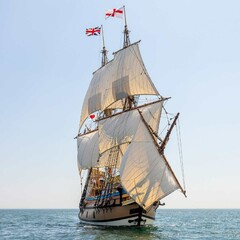
Mayflower II Museum Shop Merch
Shop exclusive Mayflower II merchandise from the Plimoth Patuxet Museum Shops! From jewelry made from wood salvaged during the ship’s restoration to apparel, children’s books, and art, the decks are stocked with a bounty of exclusive goods. Shopping Mayflower II ’s merchandise is a wonderful way to fill her sails and support her educational mission!
Shop exclusive Mayflower II merchandise
- History Classics
- Your Profile
- Find History on Facebook (Opens in a new window)
- Find History on Twitter (Opens in a new window)
- Find History on YouTube (Opens in a new window)
- Find History on Instagram (Opens in a new window)
- Find History on TikTok (Opens in a new window)
- This Day In History
- History Podcasts
- History Vault
This Day In History : September 16
Changing the day will navigate the page to that given day in history. You can navigate days by using left and right arrows

Mayflower departs England

On September 16, 1620, the Mayflower sails from Plymouth, England , bound for the Americas with 102 passengers. The ship was headed for Virginia , where the colonists—half religious dissenters and half entrepreneurs—had been authorized to settle by the British crown. However, stormy weather and navigational errors forced the Mayflower off course, and on November 21 the “Pilgrims” reached Massachusetts , where they founded the first permanent European settlement in New England in late December.
Thirty-five of the Pilgrims were members of the radical English Separatist Church, who traveled to America to escape the jurisdiction of the Church of England , which they found corrupt. Ten years earlier, English persecution had led a group of Separatists to flee to Holland in search of religious freedom. However, many were dissatisfied with economic opportunities in the Netherlands, and under the direction of William Bradford they decided to immigrate to Virginia, where an English colony had been founded at Jamestown in 1607.
The Separatists won financial backing from a group of investors called the London Adventurers, who were promised a sizable share of the colony’s profits. Three dozen church members made their way back to England, where they were joined by about 70 entrepreneurs–enlisted by the London stock company to ensure the success of the enterprise. In August 1620, the Mayflower left Southampton with a smaller vessel–the Speedwell –but the latter proved unseaworthy and twice was forced to return to port. On September 16, the Mayflower left for America alone from Plymouth.
In a difficult Atlantic crossing, the 90-foot Mayflower encountered rough seas and storms and was blown more than 500 miles off course. Along the way, the settlers formulated and signed the Mayflower Compact , an agreement that bound the signatories into a “civil body politic.” Because it established constitutional law and the rule of the majority, the compact is regarded as an important precursor to American democracy. After a 66-day voyage, the ship landed on November 21 on the tip of Cape Cod at what is now Provincetown, Massachusetts.
After coming to anchor in Provincetown harbor, a party of armed men under the command of Captain Myles Standish was sent out to explore the area and find a location suitable for settlement. While they were gone, Susanna White gave birth to a son, Peregrine, aboard the Mayflower . He was the first English child born in New England. In mid-December, the explorers went ashore at a location across Cape Cod Bay where they found cleared fields and plentiful running water and named the site Plymouth.
The expedition returned to Provincetown, and on December 21 the Mayflower came to anchor in Plymouth harbor. Just after Christmas , the pilgrims began work on dwellings that would shelter them through their difficult first winter in America.
In the first year of settlement, half the colonists died of disease. In 1621, the health and economic condition of the colonists improved, and that autumn Governor William Bradford invited neighboring Indians to Plymouth to celebrate the bounty of that year’s harvest season. Plymouth soon secured treaties with most local Indian tribes, and the economy steadily grew, and more colonists were attracted to the settlement. By the mid 1640s, Plymouth’s population numbered 3,000 people, but by then the settlement had been overshadowed by the larger Massachusetts Bay Colony to the north, settled by Puritans in 1629.
The term “Pilgrim” was not used to describe the Plymouth colonists until the early 19th century and was derived from a manuscript in which Governor Bradford spoke of the “saints” who left Holland as “pilgrimes.” The orator Daniel Webster spoke of “Pilgrim Fathers” at a bicentennial celebration of Plymouth’s founding in 1820, and thereafter the term entered common usage.

The Pilgrims’ Miserable Journey Aboard the Mayflower
During their two‑month voyage to America, the Mayflower's passengers faced cramped quarters, rough seas, limited food and numbing cold.
How the Mayflower Compact Laid a Foundation for American Democracy
Pilgrims had to find a way to get along with "strangers" on their ship once they landed in the New World.
Why Did the Pilgrims Come to America?
They were less religious refugees than economic migrants.
Also on This Day in History September | 16

Gunman kills 12 in D.C. Navy Yard massacre
Mexican war of independence begins, opera star maria callas dies.

Wake Up to This Day in History
Sign up now to learn about This Day in History straight from your inbox. Get all of today's events in just one email featuring a range of topics.
By submitting your information, you agree to receive emails from HISTORY and A+E Networks. You can opt out at any time. You must be 16 years or older and a resident of the United States.
More details : Privacy Notice | Terms of Use | Contact Us
Settlers race to claim land in Oklahoma
Suspected christian spy is murdered, william durant creates general motors, united states imposes the draft.
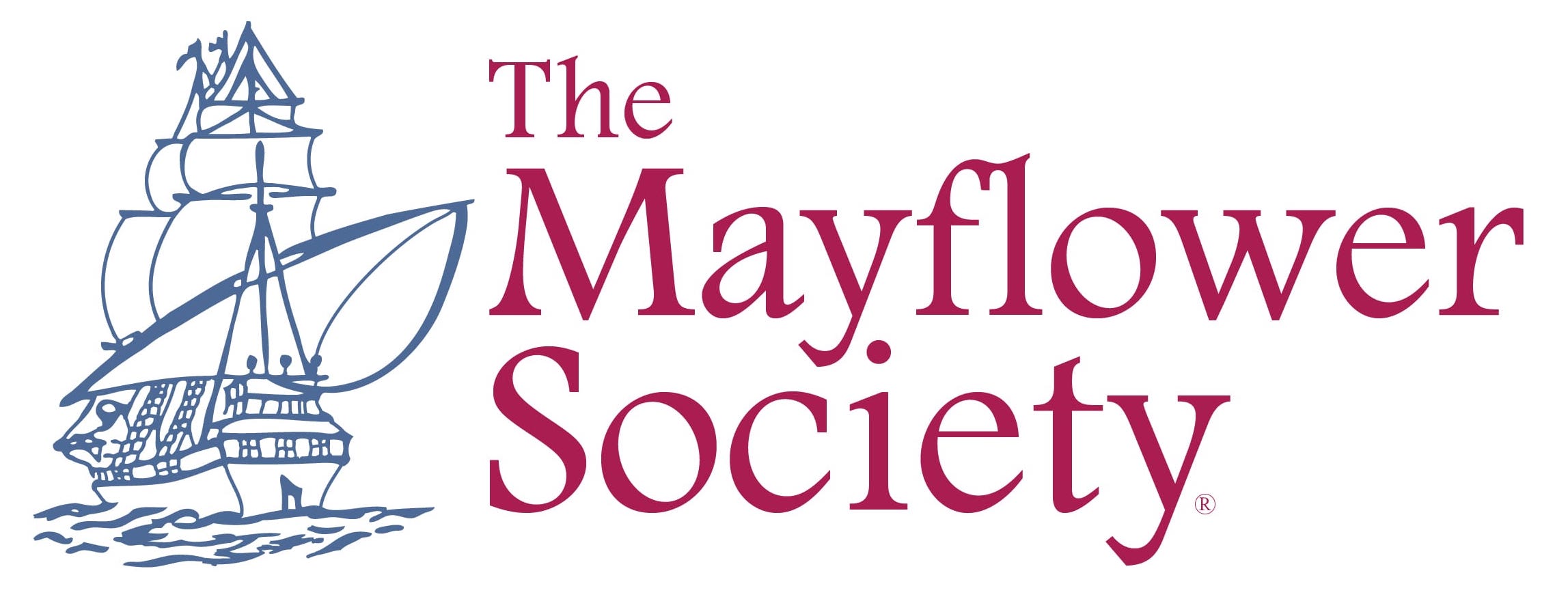
The Mayflower Voyage
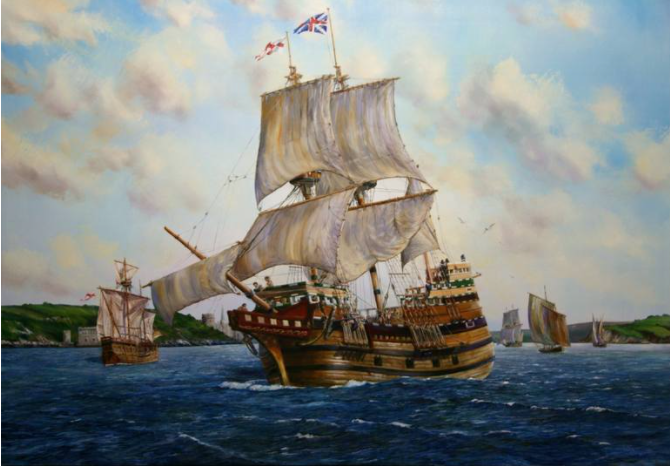
It is hard for us in this present age to imagine what it would be like not to know certain things – not know how wide the oceans were; – not to know how far Virginia was from Plymouth, England; – or from Plymouth, Massachusetts, for that matter; not to know, even, how far a ship would sail in a day or a week, and not to have any maps or charts of a good degree of accuracy for any country or any ocean on earth. All of this lack of knowledge was the situation 1620.
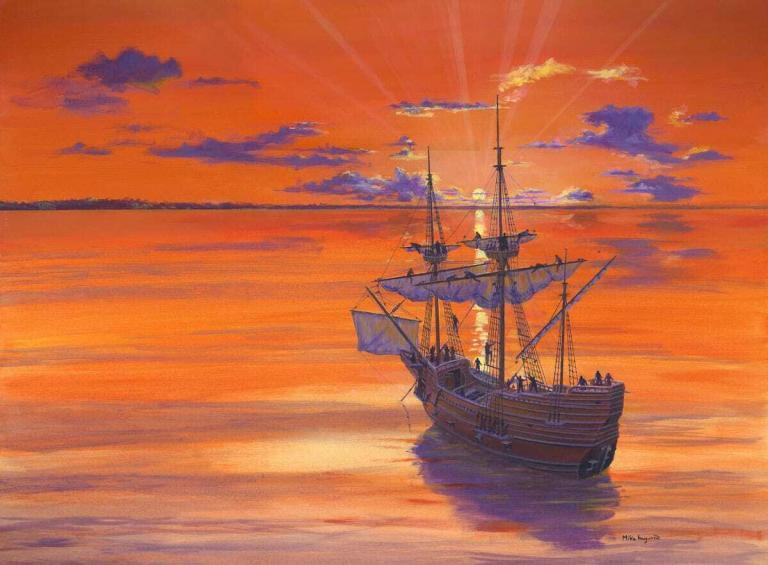
Now, of course, there was much sea-faring in 1620. Ships plied the English Channel, sailed up and down the coast of France and Spain and swarmed all over the Mediterranean. But this was mainly coastal, short voyage work. In any trip the length of time out sight of land was minimal. This is not to say that there were not trans-ocean voyages in the period. The gold trade between Spain and Mexico had flourished for years. The cost in lives and ships and cargo had been and continued to be terrific. The many recent treasure finds from sunken Spanish galleons in waters near Florida bear vivid witness to the awful costs of these many passages. These costs in men, ships and cargo were due in great degree to the ignorance of the crews and skippers and navigators. In those days the practitioners of the sea-faring art had no ability to determine accurately, on a day to day basis, their ship’s position or what dangers lurked.
So much for the state of the art in 1620. What do we find as to how many of these meager skills were possessed by Captain Jones and his crew aboard the Mayflower?
We know that Captain Jones was a part owner of the ship and had been Captain for several years. He had just returned from Spain, hauling a cargo of wine. He had traded at least once across the North Sea to Norway from Newcastle. He was probably as well suited to, and trained for, an Atlantic crossing as the average sea captain of the day. To understand just what is involved in making a crossing, whether back then or today, it is necessary to get a bit technical and describe some of the essentials of navigation and passage making in any age.
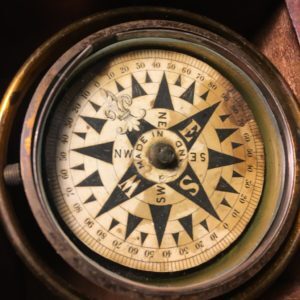
When out of sight of land, the navigator depends on several aids to keep his ship on course and to position her daily on the surface of the ocean. Then, as now, the first aid is the compass. With it he can shape his course steadily toward his destination. All of us know something about a compass, and how its north-seeking needle points to magnetic north. The discovery and use of the magnetic properties of ferrous compounds goes way, way back in time. One of the first references to a mariner’s compass is found in the writings of one Alexander Neckam, born in A.D. 1157. We are sure its use antedated this date by years and perhaps centuries.
The next aid is the traverse board . This is a kind of abacus and memo pad. A circle at the top of the board is divided by radii into the thirty-two points of the compass. Each of these radii has eight holes, evenly spaced out from the center, into which pegs can be fitted. The bottom of the board is divided by eight horizontal lines and these lines also have holes evenly spaced across their length for pegs. Then, as now, a steering watch was four hours long, divided into eight 30 minute glasses of time. At the turning of each glass (every thirty minutes), the quartermaster put a peg in the proper radius hole to represent the average course steered during the period and the proper glass number of the watch period.
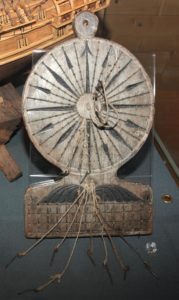
This sounds quite impressive, but the results were far from anything but rough guesses. They were at least better than no guess at all. So, with compass, traverse board and log-ship, the 1620 navigator kept his accompt book of daily positions – his dead reckoning positions. Even today, with much better compass, perfect timing devices, and excellent speedometers, the position of a ship at sea by dead reckoning may be off by a substantial mileage each day.
This leads us to the next aid the navigator must have. He must have a way of figuring his position from day to day by means independent of course or speed. The aid he uses to do this is an altitude measuring device with which he can determine the altitude of some heavenly body and, with suitable calculations, find from this measurement his location at sea. In 1620 the aids used were either an astrolabe or a Davis backstaff .
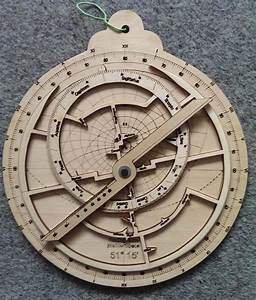
This is where Celestial Navigation comes into the picture. Celestial Navigation, in all its mathematical and astronomical theory, is rather complicated but its basic principal is simplicity itself. Poets have referred to the heavenly bodies – the sun, moon, stars and planets – as the “Lighthouses of the Sky” This poetic fancy happens to be strict, practical fact. Consider for a moment. We are on the revolving earth. It revolves from west to east, and this motion makes it appear to us that the sun and all other bodies rise in the East and set in the West. Imagine, if you will, a string running from the center of the earth to the center of a heavenly body. This string would cut the surface of the earth at a certain point at a certain time. This point is called the “GP” of the body. “GP” stands for “geographical position.” It keeps changing from moment to moment as the earth turns. Today the GP’s of fifty-seven navigational stars, four planets, the moon and the sun are listed in a Government publication issued annually and called the Nautical Almanac. This book lists these positions in terms of degrees North or South of the equator, and degrees West of an arbitrary line running through Greenwich, England. They are listed for every second of time of the year.
In 1620 no such handy volume existed. Tables of the “Declination of the Sun” for every day of the year were available, however. Declination is merely the astronomer’s name for latitude and refers to the latitude on the earth’s surface of the GP of the body. Now, remember a heavenly body moves westward in the sky rapidly, about 15 degrees an hour, but it moves slowly north or south. So a daily table of the sun’s declination is useful.
Let’s review a bit now. The aids available to Captain Jones in 1620 were the compass , the traverse board , the log ship and, of course, the second glass and hourglass. With these he did the best he could to keep his accompt book , or Log of daily dead reckoning position – his “DR.” He used his Davis backstaff or astrolabe to measure the altitude of the sun. Today he would use a sextant. This beautifully accurate instrument in the hands of a skilled observer is capable of measuring altitude angles to one six-hundredth of a degree. Captain Jones with his instrument would do well to get within a degree – some six hundred times less accurate – on board the heaving and pitching Mayflower !
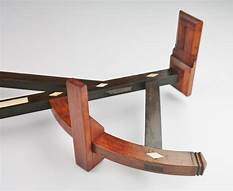
To do his best to keep from building up high cumulative errors in his dead reckoning accompt , Captain Jones practiced celestial navigation each day at high noon. High noon merely means that the sun is due north or due south of you, and is going from “rising” to “setting.” At this moment we say it is on your meridian – not A.M. or P.M. Captain Jones’s celestial navigation consisted of measuring the sun’s altitude at his best estimate of its highest point for the day.
This high point occurs at high noon (by a sun dial or compass). To make this measurement, the backstaff was probably used because it was a bit simpler on shipboard than an astrolabe. From the altitude of the sun, so obtained, and the declination for the day from the tables, Captain Jones could get his latitude by a simple calculation. We might mention here that Captain Allan Villiers carried a replica of a Davis backstaff on the voyage of Mayflower II and reported it quite useless for any meaningful accuracy. Even allowing Jones much greater accuracy than Villiers, due to more practice, it is doubtful if the latitudes obtained were much better than the DR figures which themselves were pretty awful by present day standards.
Now note that this bit of celestial observation only checked latitude. No attempt to obtain positions East or West of your departure was possible by celestial observations at that time. It would be more than a hundred years later before longitude could be found at sea.
We have mentioned the sun only as a method to obtain latitude. For centuries navigators had known that the altitude of the Pole Star, Polaris, roughly equaled the latitude of the observer. At the time of the Mayflower voyage, it is likely that Captain Jones felt he could get better results from observations of the sun. Of course, he might have observed either from time to time.
There is a whole set of circumstances in seventeenth century sailing which must not be overlooked. We must remember the life aboard a ship at those times– the almost unbelievable discomfort, the monotony, week after week after week, the cold, the wet, the poor food coupled with hard physical labor. This terrible environment made it practically impossible to exercise the careful judgment and carry out the accurate calculations which, then as now, are absolutely essential in the practice of navigation. There is no wonder that whole fleets of ships were sunk and wrecked on unfamiliar shores, and that a seaman’s life was hard and short in those far off times.
The Mayflower made history by carrying the Pilgrims to the New World. But never forget – SHE WAS ONE OF THE LUCKY ONES!
– November 1980 – VoL 46 No. 4

- Virginia Beach
- History & facts
Famous people
- Famous landmarks
- AI interviews
- Science & Nature
- Tech & Business
Discover something new everyday
- Famous places
- Food & Drinks
- Tech & Business
History and facts
20 Mayflower Facts: Uncovering the History of the Pilgrims’ Iconic Ship

Mayflower in Plymouth Harbor, by William Halsall.jpg William Halsall , Public domain, via Wikimedia Commons
Read Next →

The Final Journey of Martin Luther: Examining His Last Days and Death

10 Things to Know About Queen Victoria’s Last Days and Death

Elizabeth I of England’s Death: Mysteries and Stories
1. the mayflower transported the pilgrims, 2. the mayflower compact was drafted to aid self-governance in the plymouth colony, 3. the mayflower carried around 102 passengers, 4. the mayflower was originally meant to sail alongside the speedwell, 5. the mayflower was a cargo ship primarily designed to transport goods, 6. the voyage from england to the new world took about 66 days, 7. the ship’s crew included a master, a boatswain, a cook, and sailors, 8. the journey of the mayflower was hit by a first harsh winter in 1620, 9. the mayflower arrived at cape cod on november 21, 1620.

036-Bona Fide Picture of the Mayflower.jpg Nye, Edgar Wilson “Bill” (1850-1896) , Public domain, via Wikimedia Commons
10. The Pilgrims celebrated the first Thanksgiving in November 1621
11. the mayflower never made another voyage after its return to england, 12. a baby was born during the journey of the mayflower, 13. the mayflower ii is a full-scale replica of the mayflower.

Mayflower II. jpg Ltam46 , CC BY-SA 4.0 , via Wikimedia Commons
14. The Mayflower II is currently a museum ship
15. the mayflower was initially intended to sail to the virginia colony, 16. the mayflower’s average speed during the voyage was around 2 miles per hour, 17. the mayflower had three levels, 18. the mayflower was equipped with four cannons for protection against pirates, 19. captain jones was the master of the mayflower , 20. over 30 million people can trace their ancestry back to the mayflower passengers.

Planning a trip to Paris ? Get ready !
These are Amazon’s best-selling travel products that you may need for coming to Paris.
- The best travel book : Rick Steves – Paris 2023 – Learn more here
- Fodor’s Paris 2024 – Learn more here
Travel Gear
- Venture Pal Lightweight Backpack – Learn more here
- Samsonite Winfield 2 28″ Luggage – Learn more here
- Swig Savvy’s Stainless Steel Insulated Water Bottle – Learn more here
Check Amazon’s best-seller list for the most popular travel accessories. We sometimes read this list just to find out what new travel products people are buying.
Brian is a passionate nursing student at Kenyatta University. His heart beats for discovering Kenya's riches and beyond. Brian enjoys reading literature about the human anatomy and recounting his exploits. The Great Dixter House serves as the backdrop for his first article, a masterwork that brings to life locations he can only dream of seeing. Brian's writing is a trip through the delights of people, food, culture, history, and architecture.
Hello & Welcome

Popular Articles

Top 20 Streets to See in Paris

Paris in two days

Top 15 Things to do Around the Eiffel Tower

The Best Way to Visit Paris Museums

Top 15 Fashion Stores in Le Marais
Visit europe with discover walks.
- Paris walking tours
- Montmartre walking tour
- Lisbon walking tours
- Prague walking tours
- Barcelona walking tours
- Private tours in Europe
- Privacy policy
© 2024 Charing Cross Corporation
Have Fun With History
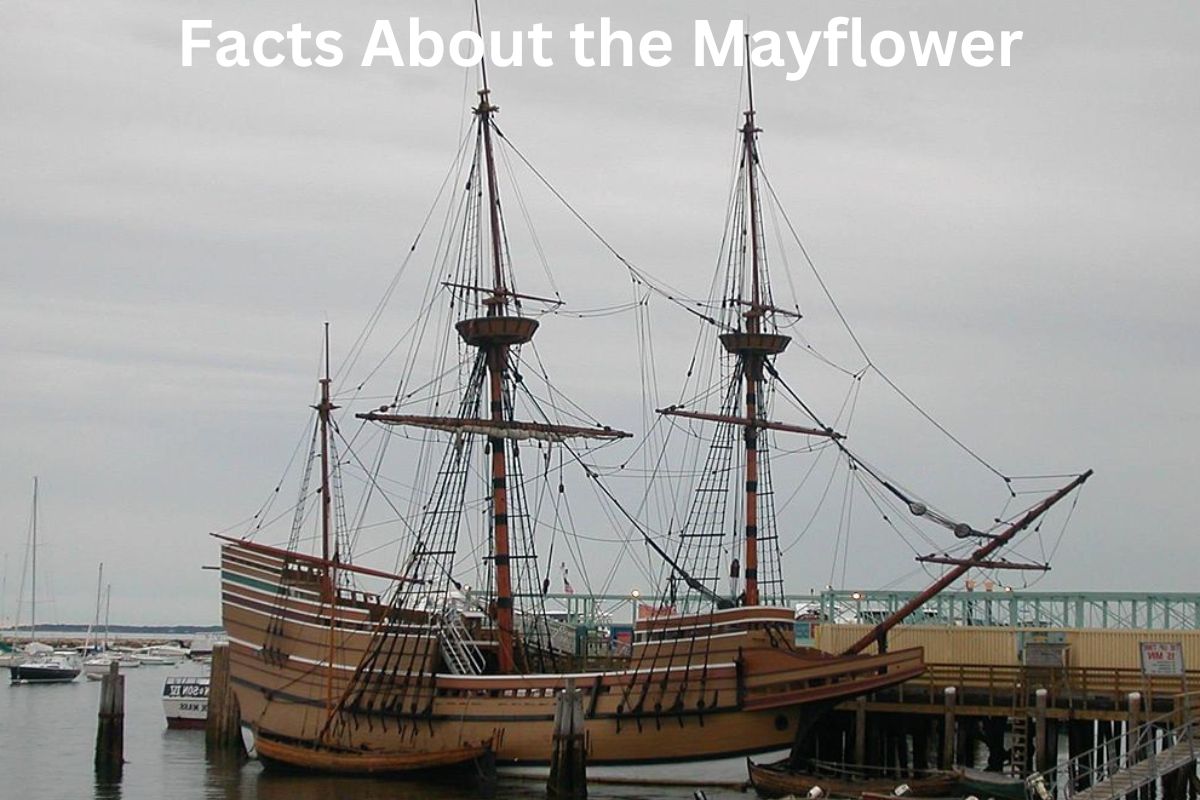
10 Facts About the Mayflower Ship
The Mayflower was the vessel that brought the first English Puritans, who are now commonly referred to as the Pilgrims, from Plymouth, England to the continent of North America in 1620.
The voyage of the Mayflower and the people who boarded it had a crucial part in the early colonization and settlement of the Americas. The Pilgrims were looking for religious freedom and a better living when they made the journey to the New World.
The ship had set sail with the intention of docking in northern Virginia; but, adverse weather conditions and mistakes in navigation caused it to instead arrive in what is now the state of Massachusetts, in the region that is now home to the city of Plymouth.
The Plymouth Colony was the first successful and long-lasting English settlement in New England, and it was founded by the Pilgrims. Plymouth was in the southeastern part of the state of Massachusetts.
The voyage of the Mayflower and the settlement of the New World by the Pilgrims is an important chapter in the annals of United States history, and it is commemorated annually on Thanksgiving .
Mayflower Facts
1. at about 180 tons, she was considered a smaller cargo ship.
The Mayflower was considered a smaller freight ship and was not specifically constructed for ocean journeys. It was largely used to transport goods between England and Bordeaux, such as clothing and wine.
It was, however, outfitted with the required rations and supplies to complete the journey across the Atlantic and was deemed capable of meeting the voyage’s demands.
Despite its small size and lack of ocean crossing experience, the Mayflower successfully brought the Pilgrims to the New World.
2. The Mayflower was a popular name for ships at the time.
During the time of James I (1603-1625), there were 26 vessels carrying the name Mayflower in the Port Books of England; it is unknown why the name was so popular.
To minimize confusion with the numerous other Mayflower ships, the identity of Captain Jones’ Mayflower is based on data from her home port, her tonnage (estimated 180-200 tons), and the master’s name in 1620.
Also Read: Facts About the Mayflower Compact
It is unknown when or where the Mayflower was built, though she was designated as “of London” in later documents. In the Port Books of 1609-11, she was identified as “of Harwich” in the county of Essex, which was also the birthplace of Mayflower master Christopher Jones in 1570.
3. It was intended for two ships to travel to the New World
The Mayflower set sail from London in the middle of July 1620 and proceeded downstream on the Thames to Southampton, where it met up with the Speedwell.
It was intended for the two ships to travel to the New World together, with the Mayflower transporting the majority of the pilgrims to their new home and the Speedwell acting as a supply ship along the journey.
However, it didn’t take long before it became clear that the Speedwell wasn’t seaworthy, so the two ships were forced to make multiple stops for repairs along the trip.
In the end, it was determined that the Mayflower would be the sole vessel upon which the Pilgrims would continue their journey, while the Speedwell would sail back to England.
Also Read: Pilgrims Facts
Because of this setback, the voyage of the Pilgrims was prolonged by several weeks, and there were fewer people on the Mayflower as a result.
In spite of this, the Pilgrims persisted on their voyage until they finally reached their destination in the New World. Once there, they established the Plymouth Colony and began a new life in the Americas.
4. There are no Admiralty court documents connected to the pilgrim fathers’ voyage of 1620
There is no subsequent record that directly refers to Jones’ Mayflower after 1616 until 1624. This is remarkable for a ship trading to London because it would not normally vanish from the records for so long.
There are no Admiralty court documents connected to the pilgrim fathers’ voyage of 1620, which could be due to the odd way the pilgrims were transferred from Leyden to New England, or some of the period’s records may have been lost.
By 1620, Jones, together with Christopher Nichols, Robert Child, and Thomas Short, was one of the ship’s owners. In the summer of 1620, Thomas Weston chartered her from Child and Jones to embark on the Pilgrim journey.
Because of his membership in the Company of Merchant Adventurers of London, Weston played an important role in the Mayflower journey, and he finally traveled to the Plymouth Colony personally.
5. A second Mayflower sailed from London in 1629.
In 1629, another ship called the Mayflower set sail from London to the Plymouth Colony.
A group of settlers set out on this expedition to establish a new settlement in the New World. Unlike the Pilgrims’ famous voyage on the Mayflower in 1620, which is regarded one of the most renowned episodes in American history, this latter voyage is less well remembered.
However, it was a significant event in the history of the Plymouth Colony, contributing to the settlement’s and its existence in the New World.
The voyage of the Mayflower in 1629, as well as numerous comparable voyages conducted by other ships and groups of settlers, shaped the history of the United States and its formation as a nation.
6. The Mayflower was square-rigged ship with a beakhead bow .
The Mayflower was square-rigged, which implies that its masts were rigged with square sails. Square-rigged ships were popular because of their stability and capacity to withstand strong winds, making them ideal for long trips across the open ocean.
The Mayflower also had a beakhead bow, which was common on many ships of the time. This bow was distinguished by a sharp, curved prow designed to cut through the water more efficiently.
The Mayflower also had a high, elevated stern, which allowed the ship to carry more cargo while also protecting the crew and passengers from rough weather.
These architectural elements, combined with the ship’s robust build and skilled crew, aided the Mayflower’s memorable trip across the Atlantic and safe arrival in the New World.
7. The number of crew on board was less than 50.
The Mayflower’s commanders and crew included a captain, four mates, four quartermasters, a surgeon, carpenter, cooper, cooks, boatswains, gunners, and roughly 36 men before the mast, for a total of about 50 men.
The whole crew remained with the Mayflower in Plymouth during the winter of 1620-1621, and almost half of them died during that time. The surviving crewmen traveled back to England on the Mayflower on April 15, 1621.
8. In 2020, the 400th anniversary of the Mayflower’s landing was celebrated.
The 400th anniversary of the Mayflower arrival occurred in 2020, marking four centuries since the famed ship and its passengers arrived on the shores of what is now Massachusetts, United States.
Special displays, historical reenactments, and educational programs, as well as ceremonies and other events honoring the bravery and endurance of the Pilgrims and the crew of the Mayflower, were held to commemorate the event.
The Mayflower landing and the creation of the Plymouth Colony are significant events in American history because they signify the commencement of permanent English colonization in the New World as well as the birth of one of the United States’ earliest colonies.
The 400th anniversary of the Mayflower landing was an opportunity to reflect on history and remember the Pilgrims and their trip to the New World.
9. The government created a Pilgrim Tercentenary half dollar, with the ship depicted on the reverse and passenger William Bradford depicted on the obverse.
The United States government struck a unique commemorative coin, the Pilgrim Tercentenary half dollar, to mark the 300th anniversary of the Mayflower’s arrival.
The coin depicts the Mayflower on the reverse and a portrait of William Bradford, one of the Pilgrims’ leaders, on the obverse.
The currency was issued in 1920 and extensively disseminated as a symbol of the country’s acknowledgement of the Mayflower and the Pilgrims’ importance in American history.
The Pilgrim Tercentenary half dollar is a noteworthy piece of American numismatic history, and coin collectors prize it for its historical significance and rarity.
The release of this coin helped to raise attention to the Mayflower and the Pilgrims’ story, and it serves as a lasting homage to their bravery, dedication, and endurance in making the momentous voyage to the New World.
10. A replica of the Mayflower, built in 1956, can be seen at the Pilgrim Memorial State Park in Plymouth, Massachusetts.
The Mayflower model can be seen in the Pilgrim Memorial State Park in Plymouth, Massachusetts. This replica was created in 1956 to honor the ship’s remarkable voyage and importance in early American settlement.
The replica is a full-scale wooden sailing ship that was built utilizing traditional shipbuilding processes and materials to the greatest extent possible.
It serves as an educational and historical resource for visitors, allowing them to learn about the Pilgrims’ and early settlers’ hardships and experiences in the New World.
The replica is a renowned tourist attraction in Plymouth and a significant symbol of American history and tradition.

Watch: Luxury Yacht Loaded With 1,000 Rounds of Ammunition & Fireworks Catches Fire In California

Second Officer Of Research Vessel Lost His Leg Due To Unsafe Crane Operation, Report Reveals

ST Engineering Launches AI-Powered Smart Shipyard With 5G Infrastructure

SeaCube Becomes 1st Leasing Firm To Acquire Carrier Transicold’s OptimaLINE Refrigerated Containers

Legendary Mayflower Ship – The Vessel That Changed History and Brought America Its First Pilgrims
The Mayflower was a well-known merchant trading vessel with special significance in American and British history. In 1620, this ship ferried 102 passengers and around 30 crew members from Plymouth in England, to Massachusetts in the US.
They set up many permanent New England colonies in North America. These passengers were called English Pilgrims and lived alongside the Native American Indians and other travellers who had settled in small areas of the continent.
What Commenced the Journey?
The pilgrims, in this case, were people who believed life in the Western part of the world to be one of the New World – where opportunities could be found in larger capacities and where they were free from religious persecution. Men, women and children comprised the 102 passengers in the Mayflower ship that undertook the journey and created a place for itself in the pages of world history.
These people thought that the Church of England had begun systematic oppression and wished to leave England for this reason. They were also called separationists since they disagreed with King Henry VIII on the powers and operations of the Church.
Initially, they received asylum in the city of Leiden in Holland which was religiously tolerant then. However, many factors plagued the group, ultimately forcing them to leave Holland. They lived under the constant fear of being expelled or branded criminals. The threat of a Spanish conquest also created additional dangers. Lastly, they were beginning to lose their identity and assimilate into Dutch society. To escape to the “New Land” and start life afresh, many of these puritans began planning sea voyages to reach North America.
At that time, small colonies were already spread throughout certain parts of the Eastern coast of North America. They lived alongside the continent’s original inhabitants- the Native American Indians. Despite minor skirmishes, both groups had begun to co-exist peacefully, inspiring the Puritans to sail to America.
Planning for the Voyage
Obtaining funding was difficult during this period as voyages were costly, sufficient stocks had to be acquired, and a sturdy boat had to be hired. The expedition was primarily backed by London merchants who hoped to import goods sent from the new lands and sell them locally in Europe. Two boats were chosen for the voyage – the Speedwell, which took a large group of the Puritans, and the Mayflower, which carried other individuals and families.
The people on board the two vessels were classified: as the Saints or Separatists and The Strangers. The saints were the Puritans fleeing persecution and wishing to practice their religious beliefs in peace. On the other hand, the strangers wanted to start a new life for themselves and explore the opportunities of new land. Some initial mistrust existed between the groups, but the hazards of surviving the arduous sea voyage ensured that they got along quickly.
Men, women, and children of all ages comprised the 102 passengers of the Mayflower that undertook the first of many trans-Atlantic journeys and created a place for themselves in the pages of world history.
- The Mayflower Ship
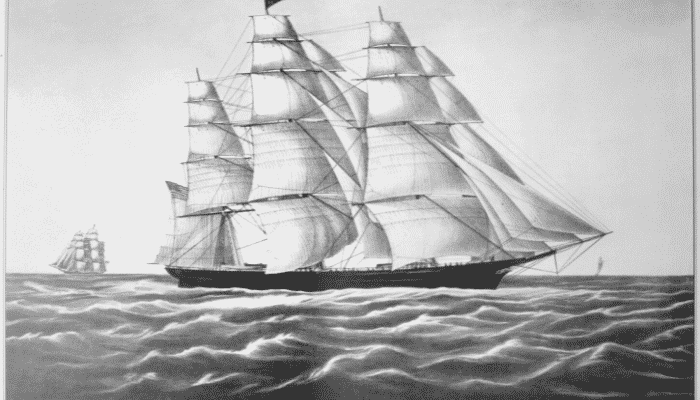
The Mayflower was a merchant trading vessel before it was used to ferry Pilgrims to the United States. In the early 17th century, the ship regularly sailed the Baltic and French coasts until it came to be used as a passenger’s vessel and was captained by Mr Christopher Jones until he died in 1622.
The Mayflower weighed 180 tons and was designated as a small trading ship designed to handle coastal journeys, not transoceanic voyages. Her main cargo was wine, clothing, and fish. Size-wise, the Mayflower measured around 30 meters in length and was nearly 8 meters at her maximum beam. It was divided into three decks- the main deck, gun deck, and cargo hold, and used three masts for sail power.
Of the many pilgrims on board the Mayflower, two noted individuals were William Bradford and Miles Standish. They served as the Second Governor and First Military Commander at the newly established Plymouth colony. Another person was Edward Winslow, a separatist leader and a skilled diplomat. He was instrumental in brokering peace between the Pilgrims and the Wampanoag tribe.
After the trans-Atlantic crossing, the ship returned to England on May 6th 1621, after setting sail from the United States on the 5th of the previous month. After this journey and the death of its Captain and owner Christopher Jones in 1622, the ship was sent for an Admiralty appraisal because it was unused due to its dilapidated condition.
The price that the appraisal committee agreed upon was around 128 pounds, which was relatively less for a ship of the size and calibre of the Mayflower. But owing to its ruinous condition, the agreed amount was considered fair. Interestingly, if the Mayflower Ship had been in operation, the price would have been somewhere near 700 pounds per the appraisal enquiry. Most proceeds from the appraisal went towards settling the estate and accounts of Christopher Jones.
The Voyage And Life on the Mayflower Ship
The life of the passengers on board the Mayflower Ship was like the life of passengers on any ship in that era.
The initial plan for the journey of the two boats (the Mayflower and the Speedwell) was to meet up at Southampton separately and then begin the trip across the Atlantic. The Speedwell was incoming from Holland with the Puritans when it developed a minor leak. After joining the Mayflower at Southampton, repairs were made, and the ships departed from the port on August 15th 1620.
However, further leaks forced them to turn to the port of Dartmouth, where additional repairs were carried out to contain the leaks. Unfortunately, the ship continued taking on water after leaving Dartmouth, and both vessels eventually returned to Plymouth on the English coast.
At Plymouth, some passengers abandoned hopes of reaching America and stayed back. Around 20 others were transferred from the Speedwell to the Mayflower, along with rations and goods. Various theories exist about why the otherwise sturdy Speedwell had developed problems, but nothing could be proven. One theory suggested that the Captain did not wish to sail to America and had created leaks to force the ship back. Other theories suggested that the vessel was severely overcrowded from the people, goods, and livestock on board.
Finally, the Mayflower left Plymouth on September 16th 1620 and sailed Westwards towards North America. The initially planned landing site was the Colony of Virginia, where permission had been granted for the group to arrive and stay. The necessary paperwork had been completed and submitted to the Company of Merchant Adventurers that oversaw operations at the Colony.
The vessel was incredibly cramped, as it was not designed to hold 130 people on board. However, trust rapidly grew between the various groups on board, and they were able to create some measure of order and privacy. Several Puritans ensured that the group stayed motivated by regularly enthralling them with the tales of the wonders awaiting them at the New Land. Several Biblical parallels have been drawn between the Pilgrims and religious persecution throughout history.
The voyage was arduous due to the poor weather and frequent storms that plagued the Mayflower. Living conditions were cramped, and the weather continually battered the ship. Several unfortunate incidents occurred, including the death of a servant on board. However, a baby was born during the voyage and was aptly christened Oceanus.
Food provisions consisted mainly of salted fish, hardtack, salted beef, and cheese. It has to be added that these food products were not nutritious and considerate of the passengers’ health at all. However, unexpected delays in England had reduced the stores on the Mayflower, despite food items being transferred from the Speedwell. Additionally, the Mayflower Ship’s hygiene was questionable, as privacy was non-existent. But it must be noted that despite all these drawbacks, the Mayflower Ship successfully sailed through the Atlantic Ocean and reached North America.
The Pilgrims aimed at berthing close to the Colony of Virginia near the Hudson River, as there were earlier colonies in this region. However, due to the storms and treacherous waters, they landed further North than expected. Rather than attempt a risky South journey by ship, the Pilgrims decided to dock at the first available land in sight. On November 9th, 1620, the coast of Cape Cod came into view, and it was agreed to berth there.

Initial Settlements and Life in America
The Pilgrims settled on Cape Cod in Massachusetts and explored present-day Plymouth while planning where to set up a permanent colony. Initial contacts were made with the local tribes, but no effort was taken to maintain this contact. Moreover, the tribes were wary of the Pilgrims due to their experiences with colonialism and the widespread diseases of the previous century. However, small tokens were left by the local tribes, such as baskets of corn, to help the Pilgrims survive the winter.
Winter at Provincetown (where they initially settled) was extremely harsh, and less than half the initial population survived the extreme conditions. They began setting up houses for the remaining people, and efforts were taken to establish a legal order within the Colony. This was done earlier by the Mayflower Compact that was drawn up on board the Mayflower and signed by 41 men. Miles Standish, a prominent Pilgrim and army officer, was chosen to enforce the Compact, and people were grouped into families to stay together.
At this time, most Pilgrims had died of disease and cold, which forced the Captain of the Mayflower- Christopher Jones, to abandon immediate plans of returning to England. However, as conditions improved amongst his crew members by March of 1621, it was decided to return in April. The Mayflower set sail back to England on April 5th and reached on May 6th, in just half the time it had taken to complete the initial voyage.
Back in America, the Pilgrims began to contact the tribes and learn essential skills. Their first established contact was with the Wampanoag tribe that had lived for over 10,000 years in the area. Thanksgiving, celebrated for the first time in the Autumn of 1621, marked the first successful harvest of the Pilgrims and was celebrated alongside the tribe that had helped them survive. However, over time, mistrust developed between some members of the tribe and the Pilgrims, leading to widespread war and conflicts. This led to several deaths on both sides and irreparably broke the relationship between both groups.
After the wars that chased the Wampanoag tribe out of their ancestral land, the original group of Pilgrims began setting up colonies of their own, which gradually spread colonial occupation all over the continent. Unfortunately, the Compact, which upheld that religious freedom was allowed in the new continent, was violated on several occasions since people with varying beliefs were persecuted (Quakers). These led to divisions amongst the colonists and forced many people out of their colonies.
Legacy and Replica of the Mayflower
Because of the rich history that the Mayflower imparted to England and the United States, a replica of the original Mayflower Ship was built by naval architect William A. Baker and was christened the Mayflower II. This ship is currently on display in the Plimoth (now read as Plymouth) Plantation and measures around 106.5 feet lengthwise, 25.5 feet beam-wise and 13 feet draft-wise.
It was designed in England, using plans drawn up by Baker, who supervised the construction at the shipyards of Devon. The Mayflower II also undertook a journey similar to the one taken by the original Mayflower and reached its destination in just 53 days. It left Plymouth, England, on April 20th 1957 and arrived at Plymouth, Massachusetts, on June 22nd, 1957.
The replica is considered reasonably accurate, except for specific improvements to ensure the vessel was seaworthy for the long Atlantic journey. It underwent extensive repairs in 2012 to handle various problems that had been brought to the attention of the US Coast Guard. The 400th anniversary of the original voyage was to be celebrated in 2020, but the ongoing Coronavirus pandemic has put all plans on hold.
For today’s generation, travelling by ship means taking a cruise across oceans and visiting important places. But sailing on a boat meant seeing the world and learning from new experiences for people of that era. And this is why the journey of the Mayflower Ship needs to be widely commemorated and appreciated so that the world can understand what travelling through the Atlantic waters meant to the people of that generation.
Around 10 million people living in the US can directly trace their ancestry to the original Pilgrims on the Mayflower board. This includes several prominent actors, politicians, business people, and Presidents. Despite the immense significance of the journey, the subsequent history of the colonists in the New Land was filled with wars and violence. This affected the continent’s indigenous inhabitants for the worse, and today, they live as a minority in their lands.
Frequently Asked Questions
1. why is the mayflower ship so famous.
Mayflower is a well-known vessel with special significance in American and British history. In 1620, this ship carried 102 passengers and 30 crew members from Plymouth in England to Massachusetts in the US, establishing the first New England colonies in North America.
2. How many people died on the voyage?
Although the journey was dangerous, fortunately, only one out of the 102 died on the 66-day-long journey. Sadly, their fortunes turned for the worst once they got down at Cape Cod.
3. What was Mayflower used for before becoming a passenger ship?
4. why was the mayflower replica constructed.
Due to its historical significance and popularity, a replica of the original Mayflower Ship was built by naval architect William A. Baker and was christened the Mayflower II. This ship was displayed in Plymouth Plantation. It measures 106.5 feet lengthwise, 25.5 feet beam-wise, and 13 feet draft-wise.
5. What happened to the Mayflower ship?
The vessel was docked in port until April when it departed for England. The actual fate of the ship is unknown and remains a mystery till day. Some say it was ultimately scrapped for its timber used to construct a barn in Buckinghamshire, England.
You might also like to read-
- Titanic Survivors – Some Noteworthy Stories You Must Know
- Christopher Columbus Ships: Vessels that Discovered America
- The Complete Story Of The Exxon Valdez Oil Spill
- The Story of the Inchcape Rock and Bell Rock Lighthouse
- Is the Queen Mary Ship Haunted?
References: Britannica, thanksgiving November

About Author
Zahra is an alumna of Miranda House, University of Delhi. She is an avid writer, possessing immaculate research and editing skills. Author of several academic papers, she has also worked as a freelance writer, producing many technical, creative and marketing pieces. A true aesthete at heart, she loves books a little more than anything else.
Read More Articles By This Author >
Disclaimer : The information contained in this website is for general information purposes only. While we endeavour to keep the information up to date and correct, we make no representations or warranties of any kind, express or implied, about the completeness, accuracy, reliability, suitability or availability with respect to the website or the information, products, services, or related graphics contained on the website for any purpose. Any reliance you place on such information is therefore strictly at your own risk.
In no event will we be liable for any loss or damage including without limitation, indirect or consequential loss or damage, or any loss or damage whatsoever arising from loss of data or profits arising out of, or in connection with, the use of this website.

Do you have info to share with us ? Suggest a correction
Daily Maritime News, Straight To Your Inbox
Sign Up To Get Daily Newsletters
Join over 60k+ people who read our daily newsletters
By subscribing, you agree to our Privacy Policy and may receive occasional deal communications; you can unsubscribe anytime.

BE THE FIRST TO COMMENT
One comment.
i know you are really good with history in famous ships i need to know more about blackbeard and his ship if you can email me some imfo.?????
Leave a Reply
Your email address will not be published. Required fields are marked *
Subscribe to Marine Insight Daily Newsletter
" * " indicates required fields
Marine Engineering
Marine Engine Air Compressor Marine Boiler Oily Water Separator Marine Electrical Ship Generator Ship Stabilizer
Nautical Science
Mooring Bridge Watchkeeping Ship Manoeuvring Nautical Charts Anchoring Nautical Equipment Shipboard Guidelines
Explore
Free Maritime eBooks Premium Maritime eBooks Marine Safety Financial Planning Marine Careers Maritime Law Ship Dry Dock
Shipping News Maritime Reports Videos Maritime Piracy Offshore Safety Of Life At Sea (SOLAS) MARPOL
WAIT! Did You Download 13 FREE Maritime eBooks?
Sign-up and download instantly!
We respect your privacy and take protecting it very seriously. No spam!
MayflowerHistory.com
The end of the mayflower.

" Mayflower 's End," by Mike Haywood.
The Mayflower returned to England from Plymouth Colony, arriving back on 9 May 1621. Christopher Jones took the ship out on a trading voyage to Rochelle, France, in October 1621, returning with a cargo of Bay salt. Christopher Jones, master and quarter-owner of the Mayflower , died and was buried at Rotherhithe, co. Surrey, England, on 5 March 1621/2. No further record of the Mayflower is found until May 1624, when it was appraised for the purposes of probate and was described as being in ruinis . The ship was almost certainly sold off as scrap.
The claim, first originating from J. Rendel Harris' book The Finding of the Mayflower (1920), that the Mayflower ended up as a barn in Jordans, England, is now widely discredited as being a figment of an overzealous imagination on the tercentenary anniversary of the Mayflower 's voyage, combined with a tainted oral history. None of the evidence has withstood subsequent investigation. Regardless of the lack of evidence for its authenticity, it has been featured in National Geographic on several occasions and is a tourist destination. It is important to realize that in 1624, when the ship was scrapped, it was not at all famous, and nobody would have thought twice about letting it rot away.

The "Mayflower Barn" in Jordans, England. This barn was identified in the 1920s as having been made from the remnants of the Mayflower . The evidence is entirely unconvincing, but that has not stopped it from becoming a tourist attraction nonetheless. Image courtesy of Wikipedia Commons.

The Voyage of the Mayflower & Speedwell
The Leiden Separatists bought a small ship, the Speedwell, in Holland. They embarked from Delftshaven on July 22, 1620. They sailed to Southampton, England to meet the Mayflower, which had been chartered by their English investors. There, other Separatists and additional colonists joined them.
On August 15, the Mayflower and Speedwell set sail for America. The Speedwell leaked so badly that both ships turned back to England, putting in first at Dartmouth and then at Plymouth. Finally, on September 16, 1620, the Mayflower set sail, alone, for America.

"The dangers were great, but not desperate; the difficulties were many, but not invincible... their ends were good & honorable... and therefore they might expect the blessing of God." - William Bradford
The Mayflower was a sizable cargo ship, around 100 feet in length. She had served many years in the wine trade. With the crowding of 102 passengers plus crew, each family was allotted very little space.

"Now all being compact together in one ship, they put to sea again with a prosperous wind." - William Bradford
The 66-day voyage was frequently stormy. At one point, a main beam cracked and had to be repaired using a large iron screw. When the passengers sighted Cape Cod, they realized that they had failed to reach Virginia, where they had permission to settle. The season was late, however, and supplies of food and water were low. They could go no further.
The Pilgrims safe arrival at Cape Cod aboard the Mayflower :
"Being thus arived in a good harbor and brought safe to land, they fell upon their knees & blessed ye God of heaven, who had brought them over ye vast & furious ocean, and delivered them from all ye periles & miseries therof, againe to set their feete on ye firme and stable earth, their proper elemente. And no marvell if they were thus joyefull, seeing wise Seneca was so affected with sailing a few miles on ye coast of his owne Italy; as he affirmed, that he had rather remaine twentie years on his way by land, then pass by sea to any place in a short time; so tedious & dreadfull was ye same unto him. But hear I cannot but stay and make a pause, and stand half amased at this poore peoples presente condition; and so I thinke will the reader too, when he well considered ye same. Being thus passed ye vast ocean, and a sea of troubles before in their preparation (as may be remembred by yt which wente before), they had now no friends to wellcome them, nor inns to entertaine or refresh their weatherbeaten bodys, no houses or much less townes to repaire too, to seeke for succoure. .. Let it also be considred what weake hopes of supply & succoure they left behinde them, yt might bear up their minds in this sade condition and trialls they were under; and they could not but be very smale. It is true, indeed, ye affections & love of their brethren at Leyden was cordiall & entire towards them, but they had litle power to help them, or them selves; and how ye case stode betweene them & ye marchants at their coming away, hath already been declared. What could not sustaine them but ye spirite of God & his grace? May not & ought not the children of these fathers rightly say: Our faithers were Englishmen which came over this great ocean, and were ready to perish in this willdernes; but they cried unto ye Lord, and he heard their voyce, and looked on their adversitie…” William Bradford, Of Plymouth Plantation

Call Mayflower at 1(800) 323-7604
- All North American Tours
- Eastern United States
- Midwest United States
- Southern United States
- Western United States
- All Central & South America Tours
- All Asia Tours
- Autumn Foliage
- River Cruises
- Special Events
- National Parks
- Scenic Rail Journeys
- Holiday Tours
- Luxury Yacht Cruises
- Motorcoach Holidays
- All Africa & Middle East Tours
- South Africa
- East Africa
- North Africa
- All Europe Tours
- Central & Eastern Europe
- Northern Europe
- Southern Europe
- Austrailia & New Zealand
- Central and Eastern Europe
- Western Europe
- South America
- Rhône and Saône
- Emerald Cruises Star-Ships
- Scenic Ultra-luxury Space-Ships
- Emerald Cruises Experience
- The Scenic Experience
- Western Mediterranean
- Adriatic Coast
- Eastern Mediterranean
- Emerald Superyachts
- Scenic Eclipse I & II
- Onboard Spaces
- Entertainment
- Luxury Suites
- Health & Wellness
- Discovery and Excursions
- Discovery Team
- Cruise Specials
- Tour Specials
- Loyalty Rewards
- Referral Rewards
- First Time Travelers
- Solo Traveler
- Cherish the Planet
- News & Articles
- Group Travel
- Mayflower Cares
- Travelers Protection Plan
- Free Home or Local Pickup (Regional)
- Press Releases
- Travel Videos
- See All Events
- See All Careers
- Monday through Friday 8:00am – 6:00pm CST Online Booking Available 24/7.
- 1 (800) 323-7604 ext. 1
Tours Provided by Mayflower Cruises and Tours
Embark on Enriching Land Tours with Mayflower Cruises and Tours
Discover the world’s captivating beauty and rich cultural tapestries with Mayflower Cruises and Tours’ exclusive selection of land tours, designed for the discerning traveler looking for exceptional value. Our carefully crafted land tours take you beyond the usual tourist paths, offering deeper insights into the local culture, history, and landscapes of some of the world’s most sought-after destinations. Whether you’re exploring the ancient ruins of Europe, the vibrant cities of Asia, or the natural wonders of the Americas, Mayflower ensures an immersive experience that combines luxury, comfort, and affordability. With special savings integrated into our packages, these tours not only promise adventure and discovery but also offer incredible value, making your travel experiences more affordable. Join us on a Mayflower land tour, where unforgettable memories are made accessible through our special promotions and discounts.

Enchanting Eastern Canada
Save $200 per couple.
8 DAYS • 14 MEALS
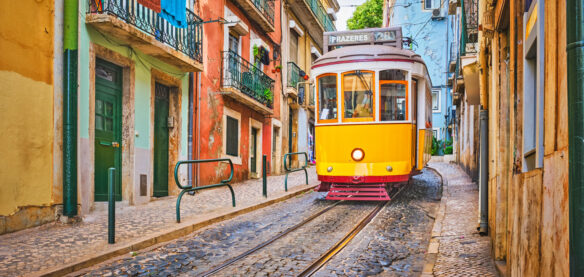
Best of Portugal
10 DAYS • 11 MEALS

Canadian Rockies by Rail

Winter in Yosemite National Park
Save $100 per couple.
6 DAYS • 9 MEALS

South Africa Highlights and Safari
8 DAYS • 12 MEALS

New England Rails and Sails
Free round trip airfare.
9 DAYS • 14 MEALS

Colorado’s Historic Trains
9 DAYS • 14 MEALS

Splendid Scotland
9 DAYS • 10 MEALS
Request a quote Tours
Next steps: sync an email add-on, request a quote scenic river cruises, deluxe verandah suite.
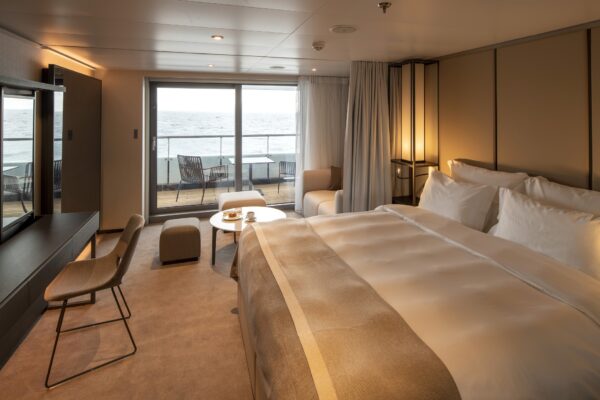
32m² / 344ft²
Suite inclusions.
- Private Verandah
- Luxury king size Scenic Slumber Bed
- Separate sleep zone
- Separate lounge area
- En-suite bathroom with shower and vanity
- Luxury bathroom amenities
- Advanced Heating, Ventilation and Air-Conditioning system (HVAC) provides 100% fresh air
- Butler service
- Shoeshine service
- Early morning tea/coffee service
- In-suite beverage service
- In-suite dining service
- Full mini-bar re-stocked daily
- Personalised butler bar featuring Illy coffee and specialty teas (replenished daily)
- HDTV entertainment system
Standard Suite | Jewel Deck
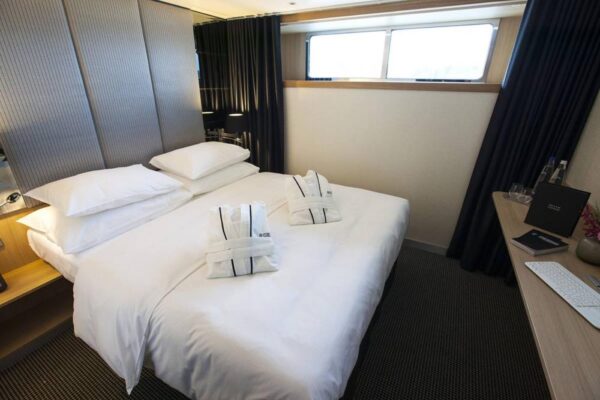
- Luxury queen size slumber bed
- Marble bathrooms
- Pillow menu
- Complimentary mini bar
- Mac-mini infotainment system
- Complimentary movies on demand
- In room safe
- Hairdryer, alarm clock, telephone
- International power sockets
- Luxurious bathroom amenities
- Luxury bathrobe and slippers
- Nordic walking sticks
- Complimentary laundry concierge service once per suite
- Shoeshine and valet service
Royal One-Bedroom Suite RP | Diamond Deck
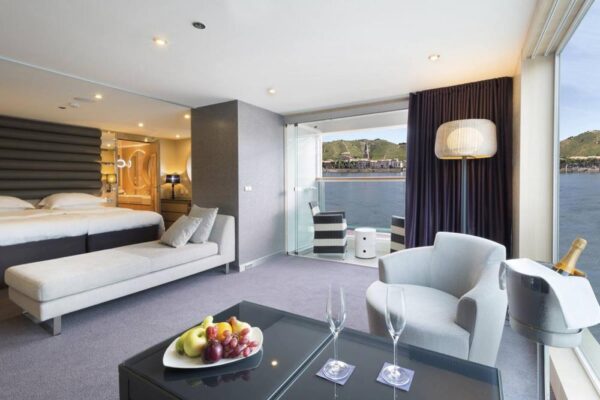
- Scenic Sun Lounge
- Marble bathrooms with upgraded bathroom amenities
- Mac-mini infotainment system with complimentary movies on demand
- Hairdryer, alarm clock, telephone, In room safe
- Unlimited complimentary laundry service
- Daily delivery of personalised savoury and sweet canapes or fruit
- Complimentary welcome bottle of Champagne (750ml)
- Morning delivery of newspapers
- Beverage and meal service in your private suite
- Packing and unpacking your luggage
- €200 per suite on board credit for use in the Wellness Centre
- Private transfers in Europe*
- Exclusive invitation to dine at Table La Rive
- Priority dining reservations
Royal Balcony Suite R | Diamond Deck
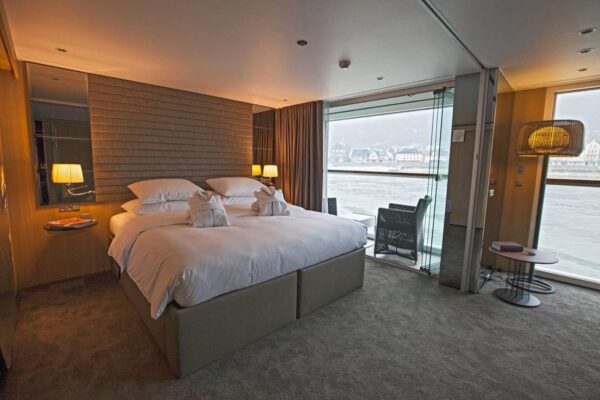
Deluxe Balcony Suite PD | Diamond Deck

- Marble bathrooms with luxurious bathroom amenities
- Complimentary laundry concierge
- Beverage service in your private suite
Balcony Suite | Diamond Deck
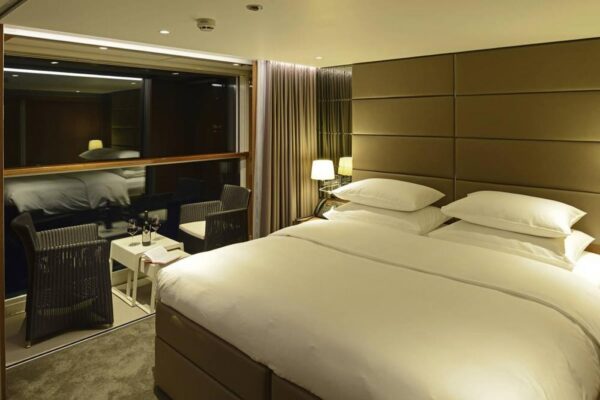
- Complimentary laundry concierge plus two pieces of pressed clothing daily
- Exclusive invitation to Table La Rive on cruises 10 nights or longer
Deluxe Balcony Suite BD | Sapphire Deck
Balcony suite | sapphire deck, riverview suite | horizon deck.
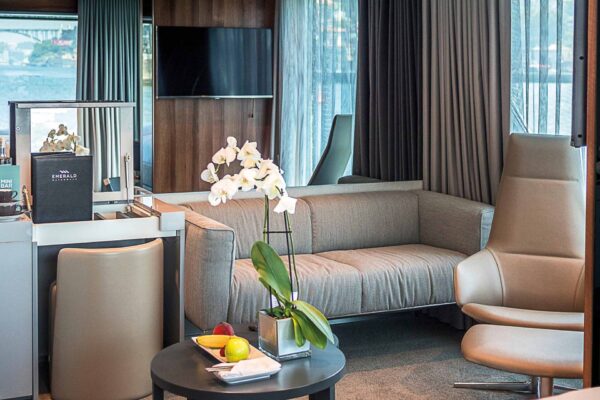
- Outdoor private balcony with open-air system
- Separate bedroom and lounge area
- Queen-size or twin hotel-style beds
- En-suite bathroom with shower, indulgent toiletries, hair dryer, on-board complimentary bathrobes and slippers
- Walk-in wardrobe
- Complimentary in-suite mini- bar, restocked daily with wine, beer and soft drinks
- Complimentary Nespresso machine
- Continental breakfast, pre-dinner canapés and after-dinner sweet treats served in your suite
- Four items of laundry per day
- Complimentary water, restocked daily
- Complimentary Wi-Fi
- Use of an iPad
- Flat screen TV and infotainment system
- Individual climate control
- Personal safe
- Walking sticks
Panorama Balcony Suite | Horizon and Vista Deck
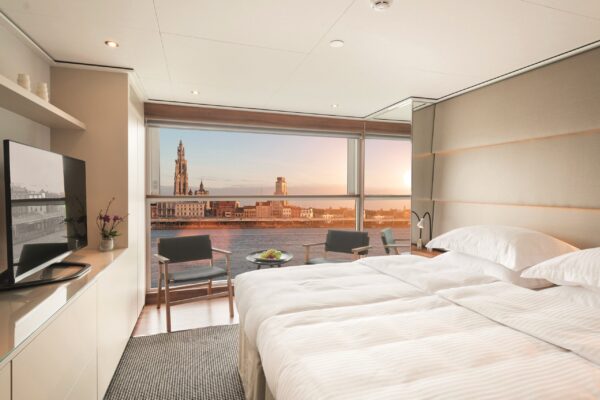
- Indoor balcony with open-air system
- Mini-bar available at own expense
Owner's One-Bedroom Suite | Horizon Deck
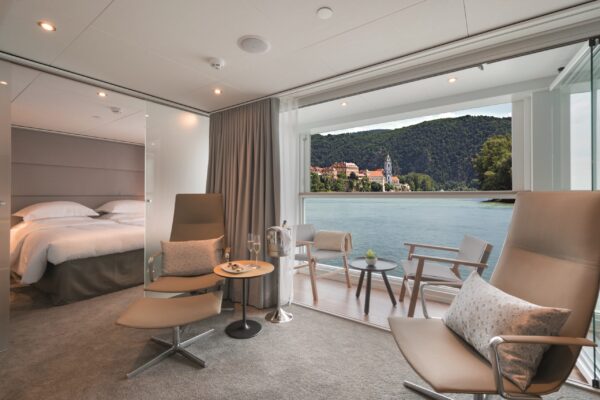
Grand Balcony Suite | Horizon Deck
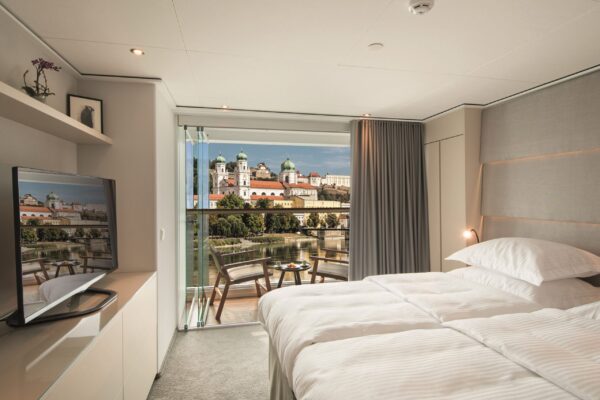
- Two items of laundry per day
Emerald Stateroom | Riviera Deck
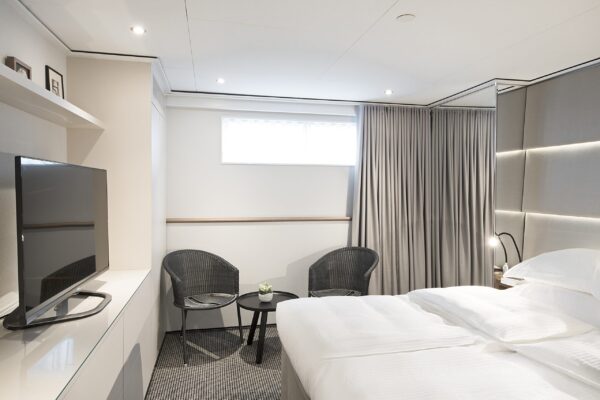
- Picture window
Tour Activity Levels
Travelers should be in reasonably good health. Please consult your physician for pre-departure health advice.
This program is a leisurely pace with a minimal activity such as climbing stares, boarding the motorcoach, and walking within the hotels and ships.
Average physical activity on this program requires the stability to climb stairs and walk reasonable distances, sometimes over uneven surfaces.
A blend of longer and shorter touring days with walking tours. Expect more of the tour to be over uneven surfaces and involve stairs.
Longer touring days with more walking tours mixed with some periods of standing. Expect more of the tour to be over uneven surfaces and involve stairs.
A more physical touring experience based on the destination. Involves longer waling tours, on uneven surfaces, ma involve inclines, stair climbing, windy or wet conditions at sites and periods of standing.. Expect some of the experiences to occur in the evening.
Oceanview Stateroom
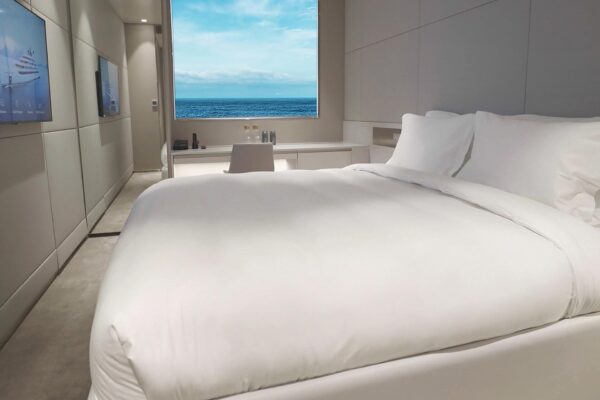
With a large ocean-view window and luxurious inclusions including Egyptian cotton bed linen and ESPA toiletries, this entry level stateroom will exceed expectations at every turn. Get ready for superb comfort, open views and exceptional value.
Between 182 sq ft and 204 sq ft
- Ocean-view window
- Magnificent position at the bow of the yacht
- Complimentary mini bar, restocked daily
- Coffee and tea-making facilitie
Balcony Suite
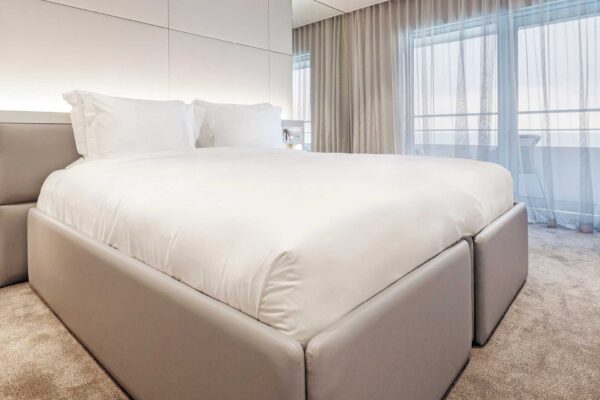
Positioned on the Pool Deck and beautifully designed with luxury inclusions, the Deluxe Balcony Suites have a stylish bedroom, separate lounge and a secluded balcony. Enjoy a fruit platter on arrival along with tea and coffee-making facilities.
Between 285 sq ft and 306 sq ft
- Private outdoor balcony
- Located on the Observation and Panorama Decks
- Coffee and tea-making facilities
Deluxe Balcony Suite

Between 382 sq ft and 403 sq ft
- Fruit platter on arrival
- Room service available during meal times
- Excellent location on the Pool Deck
Owners Suite
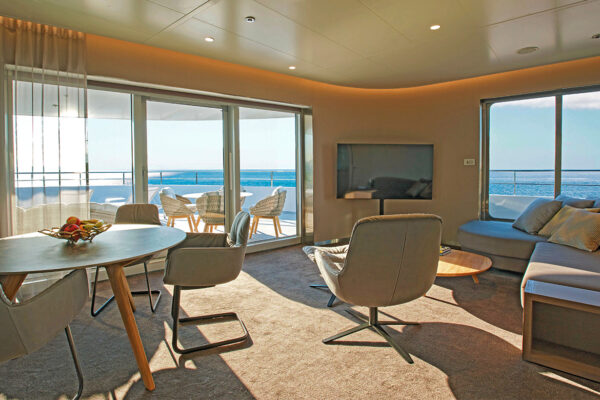
With dazzling views and oversized proportions, the Owner’s Suite is the largest and most prestigious on board. Positioned on the Pool Deck, it boasts a vast private terrace where you can relax and soak up the scenery in style. Inside, there’s a separate bedroom, plush walk-in robe and lounge area.
Between 1,162 sq ft and 1,192 sq ft (includes outside terrace)
- Your own private terrace
- Welcome bottle of champagne
- Pre-dinner canapés
- After-dinner sweets
- Complimentary mini-bar, restocked daily
- Four items laundered daily
Terrace Suite
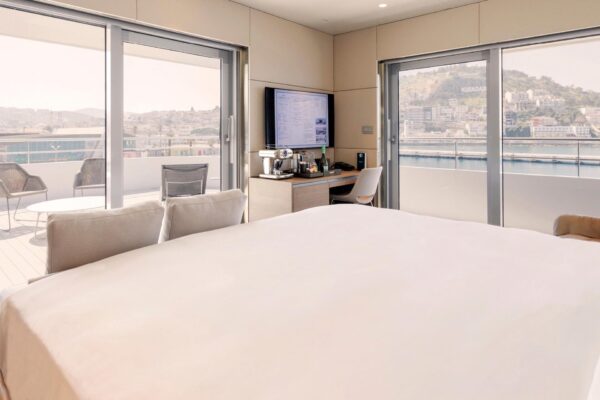
Our Terrace Suites, also among our most prestigious, have a roomy bedroom and large terrace, positioned at the back of the Panorama Deck. There’s plenty of room for relaxing on the terrace and there are key luxury inclusions: a pillow menu and laundering of two items of clothing for those special occasions on board.
Between 648 sq ft and 669 sq ft (includes outside terrace)
- Two items laundered daily
Yacht Suite
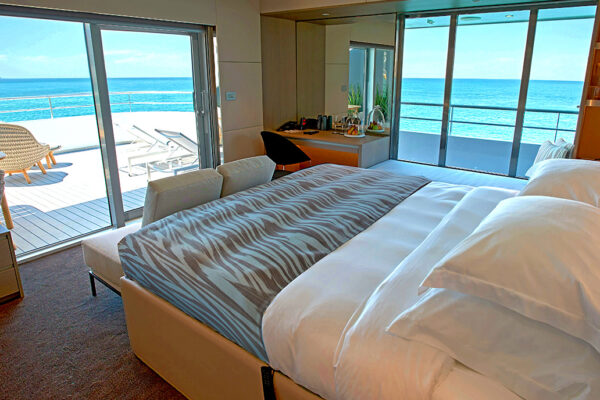
Relish the sea breeze and the sensational views from the generous private terrace of your Yacht Suite, positioned just aft of the Observation Deck. This spacious suite is one of the most opulent and has a walk-in wardrobe, plush bed and plenty of luxury inclusions such as a complimentary bottle of Champagne.
Between 700 sq ft and 721 sq ft (includes outside terrace)

IMAGES
VIDEO
COMMENTS
Mayflower Cruises & Tours has cultivated amazing guided holidays filled with life enriching experiences since 1979. Let us take the guess work and hours of research out of planning your next getaway. Each of our holidays have been hand-crafted to include the best that each destination has to offer! Whether you are looking for a trip to the ...
Mayflower was an English sailing ship that transported a group of English families, known today as the Pilgrims, from England to the New World in 1620. After 10 weeks at sea, Mayflower, with 102 passengers and a crew of about 30, reached what is today the United States, dropping anchor near the tip of Cape Cod, Massachusetts, on November 21 [O.S. November 11], 1620.
Boston to Plymouth Day-Trip including Quincy, Plimoth Patuxet and Mayflower II. 332. Discover historic New England as you explore two iconic Massachusetts destinations on this full-day tour from Boston. Travel through Quincy, MA, the birthplace of two U.S. Presidents, and journey along the state's South Shore coastal area on route to Plymouth.
Mayflower, the ship that carried the Pilgrims from England to Plymouth, Massachusetts, in 1620. Although no detailed description of the original vessel exists, marine archaeologists estimate that the square-rigged sailing ship weighed about 180 tons and measured 90 feet (27 metres) long.
In September 1620, a merchant ship called the Mayflower set sail from Plymouth, a port on the southern coast of England. Normally, the Mayflower's cargo was wine and dry goods, but on this trip ...
Mayflower II. Along with national treasures such as the Statue of Liberty and the Lincoln Memorial, Mayflower is an iconic symbol of freedom. Of the hundreds of ships that made the transatlantic crossing in the 1600s, she is the ship we remember. Three hundred years later, on June 13, 1957, a full-scale reproduction arrived in Plymouth Harbor ...
"The boat would have been rolling like a pig," says Conrad Humphreys, ... The Mayflower was about 100 feet long from stem to stern and just 24 feet wide. In addition to its 102 passengers, the ...
Mayflower II. Climb aboard the Mayflower II to share the experience of the Mayflower Pilgrims in 1620 when the Pilgrims crossed from England to America. A gift from the U.K. to the U.S. in 1957 for their friendship during the Second World War, this boat is a full-scale reproduction of the real Mayflower that sailed the Atlantic Ocean for 66 days.
Mayflower departs England. On September 16, 1620, the Mayflower sails from Plymouth, England, bound for the Americas with 102 passengers. The ship was headed for Virginia, where the colonists ...
Following that, Christopher Jones seems to have stuck with safer trading routes. The Mayflower made numerous trips primarily to Bordeaux, France, returning to London with cargoes of French wine, Cognac, vinegar, and salt.The Mayflower could freight about 180 tons of cargo.The Mayflower also made occasional voyages to other ports, including once to Malaga, Spain, and twice to Hamburg, Germany.
Mayflower in Plymouth Harbor, painting by William Halsall (1882). This is a list of the passengers on board the Mayflower during its trans-Atlantic voyage of September 6 - November 9, 1620, the majority of them becoming the settlers of Plymouth Colony in Massachusetts.Of the passengers, 37 were members of a separatist Puritan congregation in Leiden, The Netherlands (also known as Brownists ...
The Mayflower was hired in London, and sailed from London to Southampton in July 1620 to begin loading food and supplies for the voyage--much of which was purchased at Southampton.The Pilgrims were mostly still living in the city of Leiden, in the Netherlands. They hired a ship called the Speedwell to take them from Delfshaven, the Netherlands, to Southampton, England, to meet up with the ...
While the birth of the Mayflower's first baby had an ultimately tragic ending, the second child born on board went on to live to a long and prosperous life. Peregrine White was born to Susanna White while the ship was anchored in Cape Cod in late November 1620. One can only imagine how challenging it would have been to give birth on a moving ...
Take a Virtual Tour of the Mayflower. By Jessica Grimaud. September 14, 2020. A critical delay, cramped quarters, stormy seas, and an arrival 500 miles off course—such were the twists and turns that defined the Mayflower ship's voyage to America in 1620. Despite its less-than-perfect journey, the Mayflower is historically significant in ...
The Mayflower is the name of the cargo ship that brought the Puritan separatists (known as pilgrims) to North America in 1620 CE. It was a type of sailing ship known as a carrack with three masts with square-rigged sails on the main and foremast, three decks (upper, gun, and cargo), and measured roughly 100 feet (27 m) long and 25 feet (7 m) wide. The pilgrim passengers, and those not ...
Navigation in 1620: The. Mayflower. Was One of the Lucky Ones. From Diamond Jubilee Edition 27. Robert A. Harper. Presented at a meeting of the Myles Standish Colony of the Florida Society, in Naples, Florida. W hen I first thought of discussing the art of navigation in 1620 and how Captain Christopher Jones of the Mayflower probably employed ...
The Mayflower, a historical vessel, acted as the Pilgrims' unwavering transport on their momentous trip. This tough ship became the pilgrims' gateway to fresh freedom and opportunity in the early 17th century. The Mayflower set sail over the huge Atlantic, carrying the aspirations and ambitions of a brave people seeking religious liberty.
The Mayflower also had a high, elevated stern, which allowed the ship to carry more cargo while also protecting the crew and passengers from rough weather. These architectural elements, combined with the ship's robust build and skilled crew, aided the Mayflower's memorable trip across the Atlantic and safe arrival in the New World. 7.
The Mayflower was a merchant ship that usually carried goods such as wine, but its most famous cargo was the group of pilgrims destined to settle in Plymouth. The ship first set sail in August 1620 alongside another merchant ship called the Speedwell. After the Speedwell sprouted a leak, both ships returned to port, and all passengers crammed ...
The initial plan for the journey of the two boats (the Mayflower and the Speedwell) was to meet up at Southampton separately and then begin the trip across the Atlantic. The Speedwell was incoming from Holland with the Puritans when it developed a minor leak. After joining the Mayflower at Southampton, repairs were made, and the ships departed ...
The Mayflower returned to England from Plymouth Colony, arriving back on 9 May 1621. Christopher Jones took the ship out on a trading voyage to Rochelle, France, in October 1621, returning with a cargo of Bay salt. Christopher Jones, master and quarter-owner of the Mayflower, died and was buried at Rotherhithe, co. Surrey, England, on 5 March 1621/2.
On August 15, the Mayflower and Speedwell set sail for America. The Speedwell leaked so badly that both ships turned back to England, putting in first at Dartmouth and then at Plymouth. Finally, on September 16, 1620, the Mayflower set sail, alone, for America. Detail from: Mayflower & Speedwell in Dartmouth Harbor by Wilcox
Tours Provided by Mayflower Cruises and Tours Embark on Enriching Land Tours with Mayflower Cruises and Tours Discover the world's captivating beauty and rich cultural tapestries with Mayflower Cruises and Tours' exclusive selection of land tours, designed for the discerning traveler looking for exceptional value. Our carefully crafted land tours take you beyond the usual tourist paths ...